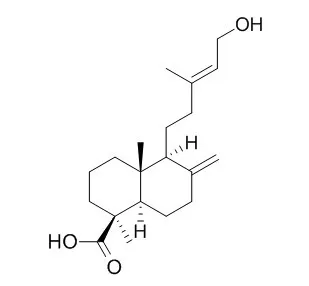| In vitro: |
| Anim Reprod Sci. 2004 Apr;81(3-4):237-44. | | Efects of the pine needle abortifacient, isocupressic acid, on bovine oocyte maturation and preimplantation embryo development.[Pubmed: 14998650] | Isocupressic acid (ICA) [15-hydroxylabda-8 (17), 13E-dien-19-oic acid], a labdane diterpene acid, isolated from ponderosa pine (Pinus ponderosa), Lodgepole pine (Pinus contorta), common juniper (Juniperus communis) and Monterey cypress (Cupressus macrocarpa), induces abortion in pregnant cows when ingested primarily during the last trimester.
The objective of this study was to investigate the effects of Isocupressic acid on bovine oocyte maturation (in vitro maturation (IVM)-Experiment I) and preimplantation embryo development (in vitro culture (IVC)-Experiment II) using in vitro embryo production techniques and to subsequently evaluate viability and developmental competence of Isocupressic acid-cultured embryos via embryo transfer to recipient heifers (Experiment III).
METHODS AND RESULTS:
A complete randomized block experimental design was used. In Experiment I and II, Isocupressic acid was added to IVM or IVC media at 0 (TRT1, control), 1.3 (TRT2), and 2.6 microg/ml (TRT3) Results from Experiment I and II indicated that Isocupressic acid did not inhibit oocyte maturation and did not adversely affect preinpiantation embryo development. Furthermore, results from Experiment II demonstrated that Isocupressic acid enhanced bovine preimplantation embryo development in vitro in a dose dependent manner. Subsequently, Day 8 (Day 0 = IVF) blastocysts cultured in vitro in the medium containing 2.6 microg/ml Isocupressic acid were transferred to recipient heifers and resulted in normal pregnancies as determined by ultrasound imaging. Subsequently, all but two births were normal as evaluated by post natal veterinary examination.
CONCLUSIONS:
In conclusion, Isocupressic acid showed no adverse effects on oocyte maturation and preimplantation embryo development in vitro or subsequent viability in vivo using the Isocupressic acid concentrations and in vitro culture parameters of this study. | | Am J Chin Med. 2002;30(4):533-41. | | Isocupressic acid blocks progesterone production from bovine luteal cells.[Pubmed: 12568280] | The needles of ponderosa pine (Pinus ponderosa Laws.) were reported to induce abortions when fed to late-term pregnant beef cows in North America. An in vivo study of pregnant cows suggested that Isocupressic acid (IA) was the main abortifacient isolated from needles and bark of the pine. However, the mechanism of abortifacient activity of Isocupressic acid is not clear yet. In a pregnant cow, the corpus luteum of the ovary helps the maintenance of pregnancy by its progesterone production.
This study involved the Isocupressic acid extracted from the root of the Taiwan cypress (Juniperus formosana) and used a frozen-thawed bovine luteal cell culture system to investigate the action of Isocupressic acid on progesterone production.
METHODS AND RESULTS:
Thawed bovine luteal cells (1 x 10(5) cells/ml/well) in M199 medium were cultured in 24-well culture plates at 37 degrees C in a 5% CO2 incubator. Ten ml of tested drugs, Isocupressic acid at 1 to 1000 ng/ml and/or ovine luteinizing hormone (oLH) at 1 to 100 ng/microl or 8-bromo-cyclic adenosine monophosphate (8-Br-cAMP) with 0.1-10 mM, were added into each well. After 4 hours of incubation, the media were harvested and assayed for progesterone by an enzyme immunoassay. Progesterone production from cells was the indicator used to evaluate the action of Isocupressic acid. All tested doses of Isocupressic acid significantly inhibited progesterone production in both basal and oLH stimulating conditions. Also those dosages inhibited cyclic adenosine-3',5'- monophosphate (cAMP) stimulation, suggesting a post-cAMP mechanism is involved in the Isocupressic acid action.
CONCLUSIONS:
We concluded that Isocupressic acid can induce pregnant cows to abort partly through blocking luteal function and may be identified as a new abortifacient chemical. | | Planta Med. 2003 Jan;69(1):69-72. | | Potential antitumor promoting diterpenoids from the stem bark of Thuja standishii.[Pubmed: 12567284 ] | Six diterpenes, including one new natural product, were isolated from a CHCl 3 extract of the stem bark of THUJA STANDISHII.
METHODS AND RESULTS:
The new compound has been characterized as 15-oxolabda-8(17),13 Z-dien-19-oic acid. The known compounds were identified as ferruginol ( 2), sugiol ( 3), Isocupressic acid ( 4), sandaracopimaric acid ( 5) and 15-oxolabda-8(17),13 E-dien-19-oic acid ( 6). Compounds 2 - 5 and the derivatives 4A and 4B were tested for their inhibitory effects on Epstein-Barr virus early antigen (EBV-EA) activation induced by 12- O-tetradecanoylphorbol 13-acetate (TPA).
CONCLUSIONS:
Compounds 2, 3, 4 and 5 showed strong inhibitory effect on EBV-EA induction (100 % inhibition at 1000 mol ratio/TPA). |
|






 Cell. 2018 Jan 11;172(1-2):249-261.e12. doi: 10.1016/j.cell.2017.12.019.IF=36.216(2019)
Cell. 2018 Jan 11;172(1-2):249-261.e12. doi: 10.1016/j.cell.2017.12.019.IF=36.216(2019) Cell Metab. 2020 Mar 3;31(3):534-548.e5. doi: 10.1016/j.cmet.2020.01.002.IF=22.415(2019)
Cell Metab. 2020 Mar 3;31(3):534-548.e5. doi: 10.1016/j.cmet.2020.01.002.IF=22.415(2019) Mol Cell. 2017 Nov 16;68(4):673-685.e6. doi: 10.1016/j.molcel.2017.10.022.IF=14.548(2019)
Mol Cell. 2017 Nov 16;68(4):673-685.e6. doi: 10.1016/j.molcel.2017.10.022.IF=14.548(2019)